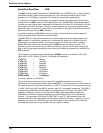
149
Glossary
L
Leased Line: A private, dedicated communications channel that connects two locations. This connection lasts for the duration of the
subscription. Leased lines may be conditioned to improve line quality over that of dial-up lines.
Line Conditioning: An additional cost option offered by the telephone company for their leased, voice-grade lines. The service
provides a careful balance of line enhancements to improve the frequency response and to reduce distortion.
LRC (Longitudinal Redundancy Check): Error checking method that generates a parity bit from a specified string of bits on a
longitudinal track. In a row and column format such as on magnetic tape, LRC is often used with VRC, which creates a parity bit for
each character.
M
Mainframe: A large, powerful computer used to centralize a data processing environment. It has hundreds of gigabytes of disk storage
space. It uses a front end processor to connect directly to the communications channels that interconnect terminals and computers.
Megabyte: One million bytes when describing a data rate. 1M of disk space may actually mean 1,048,576 bytes.
Mid-range computer: A term coined by IBM referring to any of their Advanced Business Systems computers. This product line was
originally called their mini-computers, but as the number of supported users approached mainframe capabilities, the term "mid-range"
caught on.
Mnemonics: A term assigned to a complex idea, value, or list of information which is found to be representative of that information.
Computer commands are almost entirely mnemonics. Mnemonics are used as memory aids for people.
Modem: A communications device that enables a computer to transmit information over a telephone line. It converts the computer's
digital signals into analog signals to send over a telephone line and converts them back to digital signals at the receiving end. Modems
can be internal and fit into an expansion slot, or external and connect to a serial port.
Modulation: The process of encoding information from one signal (called the source) into another (called the carrier) by modifying
some characteristic(s) of the carrier. It is often used in telecommunications when one type of signal must be converted for transmission
over an otherwise incompatible medium.
Multiplexer (mux): A device that merges several signals into one composite signal for transmission over a single medium or channel.
A de-multiplexer (usually built into a mux) reverses the process at the receiving end.
N
NAK (Negative Acknowledgment): Communications code used to indicate that a message was not properly received, or that a
terminal does not wish to transmit. Contrast with ACK.
Network: A group of computers connected by cables or other means and using software that enables them to share equipment, such
as printers and disk drives to exchange information.
Node: Any point within a network which has been assigned an address.
Normal mode: In modem operation, refers to a mode of operation without error correction active.
O
Off-hook: The condition of a device which has accessed a phone line (with or without using the line). In modem use, this is equivalent
to a telephone handset being picked up. Dialing and transmission are allowed, but incoming calls are not answered.
On-Hook: The condition of a device which has not accessed a phone line. In modem use, this is equivalent to a telephone handset that
has not been picked up. In other words, it can receive an incoming call.
P
Parameter:
1. A "place holder" in a command which should be substituted with useful information.
2. The list of acceptable values for a given option or command. In UNIX, the generic command should be typed in as Stty/s 9600.
Where "Stty" is the command, "s" is the speed switch, and "9600" where s=1200-115,200 bps.
Parity bit: An extra bit attached to each byte of synchronous data used to detect errors in transmission.
PCB (Printed Circuit Board): A flat board that holds chips and other electronic components. The board is "printed" with electrically
conductive pathways between components. The main PCB in a system is called a motherboard and the smaller PCBs that plug into the
slots in the motherboard are called daughter boards or cards.


















